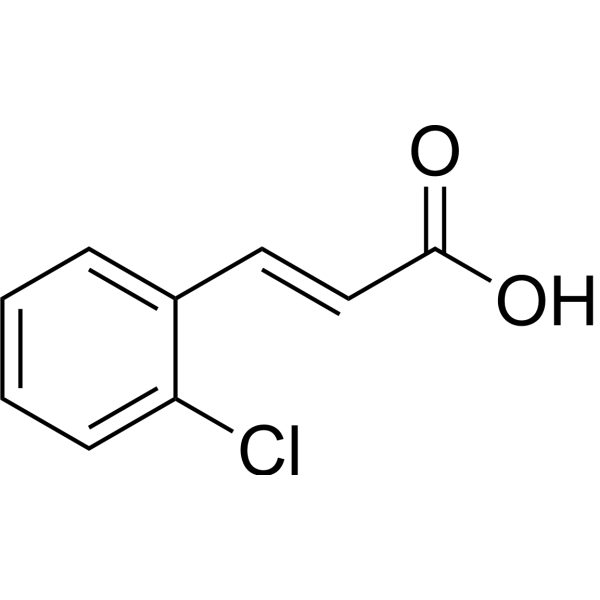
2-Chlorocinnamic acid
CAS No. 3752-25-8
2-Chlorocinnamic acid( —— )
Catalog No. M30923 CAS No. 3752-25-8
2-Chlorocinnamic acid is a photosensitive compound, it can inhibit tyrosinase activity. 2-Chlorocinnamic acid and 4-chlorocinnamic acid show potent urease inhibitory activities with the respective IC50 values of 0.66 and 1.10 uM.
Purity : >98% (HPLC)
 COA
COA
 Datasheet
Datasheet
 HNMR
HNMR
 HPLC
HPLC
 MSDS
MSDS
 Handing Instructions
Handing Instructions
| Size | Price / USD | Stock | Quantity |
| 50MG | Get Quote | In Stock |


|
| 100MG | Get Quote | In Stock |


|
Biological Information
-
Product Name2-Chlorocinnamic acid
-
NoteResearch use only, not for human use.
-
Brief Description2-Chlorocinnamic acid is a photosensitive compound, it can inhibit tyrosinase activity. 2-Chlorocinnamic acid and 4-chlorocinnamic acid show potent urease inhibitory activities with the respective IC50 values of 0.66 and 1.10 uM.
-
Description2-Chlorocinnamic acid is a photosensitive compound, it can inhibit tyrosinase activity. 2-Chlorocinnamic acid and 4-chlorocinnamic acid show potent urease inhibitory activities with the respective IC50 values of 0.66 and 1.10 uM.
-
In Vitro——
-
In Vivo——
-
Synonyms——
-
PathwayOthers
-
TargetOther Targets
-
Recptor——
-
Research Area——
-
Indication——
Chemical Information
-
CAS Number3752-25-8
-
Formula Weight182.61
-
Molecular FormulaC9H7ClO2
-
Purity>98% (HPLC)
-
Solubility——
-
SMILES——
-
Chemical Name——
Shipping & Storage Information
-
Storage(-20℃)
-
ShippingWith Ice Pack
-
Stability≥ 2 years
Reference
molnova catalog



related products
-
GDC046
GDC046, a potent lead analog, has good kinase selectivity, physicochemical properties and pharmacokinetic profile.
-
AG-1557
Detail unknown.
-
UDP-xylose disodium
UDP-xylose disodium is a compound that can be isolated from Cryptococcus laurentii and is a sugar donor that can be used for the synthesis of glycoproteins, polysaccharides, various metabolites and oligosaccharides in plants, vertebrates and fungi.



 Cart
Cart
 sales@molnova.com
sales@molnova.com


